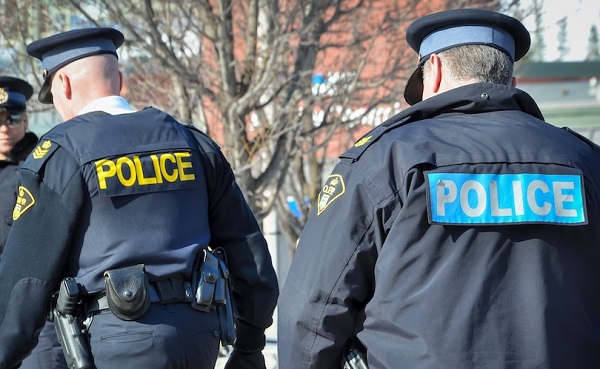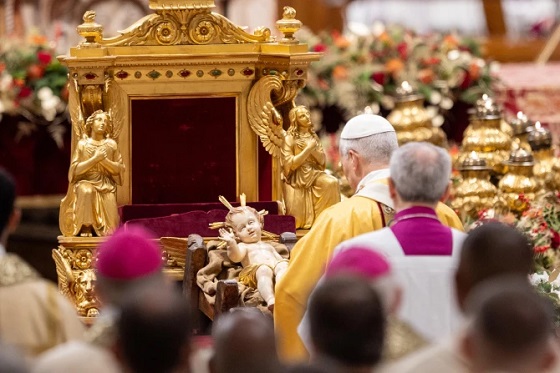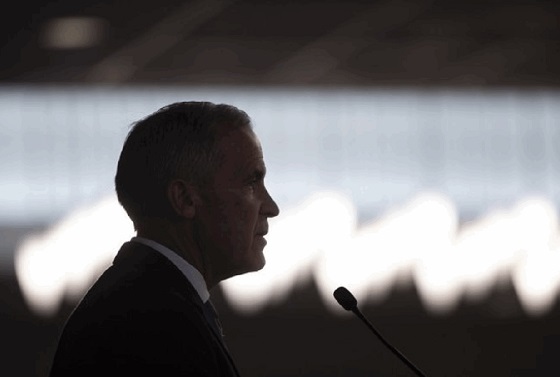Censorship Industrial Complex
Retired judge says Freedom Convoy organizers on trial represent all opponents to current government

From the Frontier Centre for Public Policy
By Brian Giesbrecht
Hold the line
The marathon trial of Tamara Lich has resumed. This is definitely the most high-profile trial in Canada in years. Millions of our tax dollars have been spent to prosecute this Métis grandmother (and Chris Barber). Seasoned prosecutors have been seconded, and all of the resources of both the federal and Ontario governments have been employed to get a conviction. Seemingly at any cost.
So, the charges must be extremely serious? Surely, we are talking about some deadly terrorist attack, or something that involves multiple murders and mayhem – at the least!
Well…, no. That tiny, polite grandmother is charged, essentially, with……. mischief.
Mischief? Isn’t that a charge that is usually used to deal with a kid spray-painting graffiti on a wall, or an inebriated fellow doing something foolish while under the influence?
Not so, in the case of Tamara. They are going after her with everything at their disposal. They are pulling out all the stops – spending millions of dollars of our money to nail this gentle, former physical fitness trainer and bookkeeper on a tarted-up charge of mischief. They seem determined to make an example of her.
But an example of what? Here’s my answer: An example of what will happen to any of us if we express views that the government in power does not like -what our Prime Minister refers to as “unacceptable views” that conflict with his progressive vision. They aren’t just going after Tamara; they are going after us.
If you doubt this, think of any protest in memory that has the support of progressives, where any of the organizers have been prosecuted so vigorously just to teach that person a lesson.
After all, there are no shortage of protests. We have had dozens of indigenous, BLM, climate, and Palestinian protests in recent years. Every large protest attracts some undesirables, who participate in violence and mayhem. The BLM and antifa protests – the one our PM actively participated in despite all of his lockdown rules then in place – toppled statues and did much property damage. Surely at least one of the Canadian protest organizers could have been charged, as Tamara was. Not so.
But the vast majority of the people participating in these large protests simply want to make their point. That’s the purpose of protests. They allow people to have their say, and let off steam. Our western liberal democracies allow such things. In fact, without active citizen participation, our liberal democracies would wither and die. Citizens of liberal democracies must be free to peacefully protest when they feel the need to do so. Democratic governments must be robust enough to tolerate protests, and other forms of dissent.
In the trucker convoy protest the main point that the protesters wanted to make was about government overreach. They believed that the government reaction to the nasty Covid virus was extreme and overdone. The final straw was the imposition of a vaccine mandate on truckers at a time when everyone knew that the vaccine did not prevent a person from either becoming infected with, or transmitting, the virus. When the Trudeau government imposed its vaccine mandate this was known with certainty. The protestors were aware of that, and suspected that the decision to impose an unnecessary mandate was purely political. They insisted on their right to make a personal choice about what went into their bodies, and argued that the vaccine mandate was a denial of their basic freedoms. They wanted to state their case to the prime minister about it. But he had no time for them.
That’s what the convoy protest was all about. It was just one of many protests any liberal democracy has had, are having, and will have in the future.
But in how many of those protests do we find a Tamara – namely one person singled out as a sacrificial lamb? Shackled, dumped in a filthy cell, forced to share that cell with a mentally unstable person, and without even a book to read. And then hauled back and forth to court to be yelled at by openly hostile prosecutors. Followed by a year long trial. For a mischief charge. (Lich describes her ordeal in “Hold the Line.”
The answer is that where progressives rule – that’s here, folks – this only happens to people with “unacceptable views”. The authorities in progressive-run administrations only go after conservatives, because those are the people with “unacceptable views”. They leave progressives alone. Justin Trudeau will “take a knee” in protests he agrees with – but will bring the hammer down with thundering force on any “unacceptable fringe view” that he doesn’t like. Hamas protesters appear to be able do virtually whatever they want – even confining Jewish citizens to “ghettos”, and yelling vile, antisemitic slurs at them. The authorities will simply let it pass. Like Sergeant Schultz in “Hogan’s Heroes” they “see nussing”.
But if you happen to drive a truck, and insist on your right to decide what drugs will be injected into your body, you are fair game. There will be no shortage of police chiefs and other government officials willing to go after you.
That’s where we are now, with the trial in its final stages. There’s a good chance that Tamara will be acquitted. She is in front of an experienced and independent judge, and the evidence against her is contrived.
But there are many lesser-known people prosecuted during the lockdown and convoy protest who do not have Tamara’s high profile that gives her the ability to raise the hundreds of thousands of dollars she has needed to defend herself. Many ordinary Canadians have been convicted of offences relating to the lockdown and convoy protests for the simple reason that they couldn’t afford the time and money to defend themselves against often unfair charges.
Something similar is happening in Britain right now, where widespread dissatisfaction with government failure to limit and regulate mass immigration – particularly of immigrants who have no intention of integrating- has resulted in both protests, and out-of-control rioting. Mass immigration, like lockdown legislation, is a topic on which conservatives and progressives tend to disagree sharply. The Starmer government’s one-sided reaction to the protests and riots – as in the case of our lockdown regulations and convoy protest – is causing both unfairness and injustice for many ordinary Brits. There is general agreement that the thugs who participated in violence in the riots deserve their fate, and are rightly being jailed. But the vast majority of ordinary Brits, who are appalled at what uncontrolled immigration is doing to their country, are being silenced by threats of prosecution and jail.
People are being prosecuted simply for making intemperate comments on social media. Some who did not even participate in the protests are being jailed.
Those Britons are receiving the same threat that our prime minister has given to us – if you have an “unacceptable view” you had better not share it. Leaders, like Starmer and Trudeau, who choose to shame and silence half of their populations are playing with fire. They can only survive by becoming increasingly authoritarian.
Their brute message takes many forms. “Two tier policing” is one – namely, the police treating lockdown, or immigration protestors in a completely different way than they do pro-Hamas or BLM type protestors. “Lawfare” is another – weaponizing the law to go after those you disagree with. The Online Harms Act pushed by the Trudeau government will do exactly that. All involve the bullying of people who do not agree with the progressive views now in fashion.
These illiberal tactics threaten the rule of law that has evolved in western civilization through Magna Carta, and on to the present. The rule of law is fragile, and it is not compatible with opportunistic politicians who tamper with it by weaponizing the law to crush dissent, and to destroy their enemies. Those leaders risk seriously damaging our basic institutions with their cynical experiments in authoritarianism.
Canada, like Britain, also sees tension rising over the immigration issue. Most Canadians welcome controlled immigration. But they want immigrants who intend to integrate into the Canadian mosaic. This issue will become increasingly contentious, and Canadians who are opposed to what the current federal government is doing with immigration must be allowed to voice their opposition. That opposition includes the right to protest peacefully.
We are going to see many contentious issues arise over the next few decades. It is very likely that the government of the day will not like some of the views that are voiced by dissenters. The point is that Canadians must have the right to peacefully present their views, as Tamara Lich has done, without being treated the way dissidents are in authoritarian regimes. Conservative thinkers must not allow themselves to be intimidated into silence by progressives.
And we must be able to rely on our courts to protect those rights. The courts largely failed to protect the freedoms of lockdown dissenters in the COVID years. This has to change, or our individual freedoms will not be worth the paper they are written on. Overreaching governments must be held to account.
There is much to think about as the longest and most expensive mischief trial in Canadian history finally heads to its conclusion. The trial judge will tell Tamara if she is guilty or not guilty. But the Trudeau and Ford government are effectively on trial as well. Was their treatment of this one small lady something that should happen here? Is this what Canada has become? The Lich decision has the potential to be an important turning point for this country.
Tamara Lich did not lie down in front of a tank. She did not spend years in the Gulag. But she has been treated shabbily by the Trudeau and Ford governments. And in her gentle and respectful response to this Big Brother bullying she has taught us something. It is this: Stand up for your beliefs. Hold the line.
At some point the Trudeau Liberals will be relegated to the history books. What will they be remembered for? Trudeau’s imposition of The Emergency Act will certainly be on the top of that list. That is – without doubt – one of the low points in the history of this great country. But surely, the trial of Tamara Lich will be right up there on that list as well. A polite Métis grandmother, imprisoned and relentlessly persecuted for daring to stand up for what she believes in, has become an inspiration for those of us who cherish freedom.
Brian Giesbrecht, retired judge, is a Senior Fellow at the Frontier Centre for Public Policy
Censorship Industrial Complex
Canadian university censors free speech advocate who spoke out against Indigenous ‘mass grave’ hoax

From LifeSiteNews
Dr. Frances Widdowson was arrested and given a ticket at the University of Victoria campus after trying to engage in conversation about ‘the disputed claims of unmarked graves in Kamloops.’
A Canadian academic who spoke out against claims there are mass unmarked graves of kids on former Indigenous residential schools, and who was arrested on a university campus as a result for trespassing, is fighting back with the help of a top constitutional group.
Dr. Frances Widdowson was arrested and given a ticket on December 2, 2025, at the University of Victoria (UVic) campus after trying to engage in conversation about “the disputed claims of unmarked graves in Kamloops,” noted the Justice Centre for Constitutional Freedoms (JCCF) in a recent news release.
According to the JCCF, Widdowson was trying to initiate a “good faith” conversation with people on campus, along with the leader of OneBC provincial party, Dallas Brodi.
“My arrest at the University of Victoria is an indication of an institution that is completely unmoored from its academic purpose,” said Widdowson in a statement made available to LifeSiteNews.
She added that the “institution” has been “perpetuating the falsehood” of the remains of 215 children “being confirmed at Kamloops since 2021, and is intent on censoring any correction of this claim.”
“This should be of concern for everyone who believes that universities should be places of open inquiry and critical thinking, not propaganda and indoctrination,” she added.
UVic had the day before Widdowson’s arrest warned on its website that those in favor of free speech were “not permitted to attend UVic property for the purpose of speaking publicly.”
Despite the warning, Widdowson, when she came to campus, was met with some “100 aggressive protesters assembled where she intended to speak at Petch Fountain,” noted the JCCF.
The protesters consisted of self-identified Communists, along with Antifa-aligned people and Hamas supporters.
When Widdowson was confronted by university security, along with local police, she was served with a trespass notice.
“When she declined to leave, she was arrested, detained for about two hours, and charged under British Columbia’s Trespass Act—an offence punishable by fines up to $2,000 or up to six months’ imprisonment,” said the JCCF.
According to Constitutional lawyer Glenn Blackett, UVic actions are shameful, as it “receives hundreds of millions of taxpayer dollars annually while it facilitates the arrest of Canadians attempting to engage in free inquiry on campus.”
Widdowson’s legal team, with the help of the JCCF, will be defending her ticket to protect her “Charter-protected freedoms of expression and peaceful assembly.”
Widdowson served as a tenured professor at Mount Royal University in Calgary, Alberta, before she was fired over criticism of her views on identity politics and Indigenous policy, notes the JCCF. She was vindicated, however, as an arbitrator later found her termination was wrongful.
In 2021 and 2022, the mainstream media ran with inflammatory and dubious claims that hundreds of children were buried and disregarded by Catholic priests and nuns who ran some Canadian residential schools. The reality is, after four years, there have been no mass graves discovered at residential schools.
However, as the claims went unfounded, over 120 churches, most of them Catholic and many of them on Indigenous lands that serve the local population, have been burned to the ground, vandalized, or defiled in Canada since the spring of 2021.
Last year, retired Manitoba judge Brian Giesbrecht said Canadians are being “deliberately deceived by their own government” after blasting the former Trudeau government for “actively pursuing” a policy that blames the Catholic Church for the unfounded “deaths and secret burials” of Indigenous children.
As reported by LifeSiteNews, new private members’ Bill C-254, “An Act To Amend The Criminal Code” introduced by New Democrat MP Leah Gazan, looks to give jail time to people who engage in so-called “Denialism.” The bill would look to jail those who question the media and government narrative surrounding Canada’s “Indian Residential School system” that there are mass graves despite no evidence to support this claim.
Censorship Industrial Complex
Top constitutional lawyer warns against Liberal bills that could turn Canada into ‘police state’

From LifeSiteNews
‘Freedom in Canada is dying slowly and gradually, not by a single fell swoop, but by a thousand cuts,’ wrote John Carpay of the JCCF.
One of Canada’s top constitutional legal experts has warned that freedom in the nation is “dying slowly” because of a host of laws both passed and now proposed by the Liberal federal government of Prime Minister Mark Carney, saying it is “up to citizens” to urge lawmakers to reverse course.
In an opinion piece that was published in the Epoch Times on December 15, John Carpay, who heads the Justice Centre for Constitutional Freedoms (JCCF), gave a bleak outlook on no less than six Liberal laws, which he warned will turn Canada into a “police state.”
“Freedom in Canada is dying slowly and gradually, not by a single fell swoop, but by a thousand cuts,” he wrote.
Carpay gave the example of laws passed in the United Kingdom dealing with freedom of online speech, noting how in Canada “too few Canadians have spoken out against the federal government gradually taking over the internet through a series of bills with innocuous and even laudable titles.”
“How did the United Kingdom end up arresting thousands of its citizens (more than 30 per day) over their Facebook, X, and other social media posts? This Orwellian nightmare was achieved one small step at a time. No single step was deemed worthy of fierce and effective opposition by British citizens,” he warned.
Carpay noted how UK citizens essentially let it happen that their rights were taken away from them via mass “state surveillance.”
He said that in Canada Bill C-11, also known as the Online Streaming Act, passed in 2023, “undermines net neutrality.” Bill C-11 mandates that Big Tech companies pay to publish Canadian content on their platforms. As a result, Meta, the parent company of Facebook and Instagram, blocked all access to news content in Canada.
“The Online Streaming Act undermines net neutrality (all online content being treated equally) and amounts to an aggressive expansion of government control over the internet and media companies. The CRTC now has broad power over what Canadians watch, hear, and access online, deciding what is discoverable, permissible, or even visible,” noted Carpay.
Carpay also warned about two recent bills before the House of Commons: Bill C-2, the Strong Borders Act, Bill C-8, and Bill C-9, as well as the Combating Hate Act.
He cautioned that Bill C-2, as it reads, “authorizes warrantless demands for subscriber data and metadata from online providers.”
“Bill C-2 should be called the Strong Surveillance Act, as it gives sweeping powers to a host of non-police government officials to conduct warrantless searches,” warned Carpay.
He observed how Bill C-2 would grant law enforcement “unprecedented powers to monitor Canadians’ digital activity,” without any “judicial oversight.”
“Any online service provider—including social media and cloud platforms, email domain hosts and even smaller service providers—would be compelled to disclose subscriber information and metadata,” he warned.
When it comes to Bill C-8, or The Critical Cyber Systems Protection Act, Carpay warned that if passed it would “allow government to kick Canadians off the internet.”
“The government’s pretext for the Critical Cyber Systems Protection Act is to ‘modernize’ Canada’s cybersecurity framework and protect it against any threats of ‘interference, manipulation, disruption or degradation,’” wrote Carpay.
“Sadly, it remains entirely unclear whether ‘disinformation’ (as defined by government) would constitute ‘interference, manipulation, disruption or degradation’.”
Lawyer warns new laws ‘grant government unprecedented control’
Bill C-9, the Combating Hate Act, has been blasted by constitutional experts as allowing empowered police and the government to go after those it deems have violated a person’s “feelings” in a “hateful” way.
Carpay, who has warned about this bill and others, noted that when it comes to Bill C-9, it affects Canadians’ right to religious freedom, as it “removes needed protection from religious leaders (and others) who wish to proclaim what their sacred scriptures teach about human sexuality.”
“Marc Miller, Minister of Canadian Identity and Culture, has stated publicly that he views certain Bible and Koran passages as hateful. Bill C-9 would chill free speech, especially on the internet where expression is recorded indefinitely, and particularly for activists, journalists, and other people expressing opinions contrary to government-approved narratives,” he wrote.
“This law also vastly increases the maximum sentences that could be imposed if a judge feels that the offence was ‘motivated by hatred,’ and creates new offences. It prohibits merely displaying certain symbols linked to hate or terrorism in public, and extends criminal liability to peaceful protest activity.”
Carpay said that both C-8 and C-9 together “collectively grant government unprecedented control over online speech, news, streaming services, and digital infrastructure.”
He said that the Liberal federal government is “transforming Canada’s centuries-old traditions of free speech and privacy rights into something revocable at the pleasure of the CRTC, politicians, and bureaucrats,” adding that Canadians need to wake up.
“Laziness and naivete are not valid reasons for failing to rise up (peacefully!) and revolt against all of these bills, which are slowly but surely turning Canada into a police state,” he wrote.
Carpay said that Canadians need to contact their MPs and “demand the immediate repeal of the Online Streaming Act and the Online News Act,” and “reject” the other bills before the House.
When it comes to Bill C-9, as reported by LifeSiteNews, the Canadian Constitution Foundation (CCF) launched a petition demanding that a Liberal government bill that would criminalize parts of the Bible dealing with homosexuality under Canada’s new “hate speech” laws be fully rescinded.
The amendments to Bill C-9 have been condemned by the Canadian Conference of Catholic Bishops, who penned an open letter to the Carney Liberals, blasting the proposed amendment and calling for its removal.
-

 armed forces1 day ago
armed forces1 day agoOttawa’s Newly Released Defence Plan Crosses a Dangerous Line
-

 espionage1 day ago
espionage1 day agoCarney Floor Crossing Raises Counterintelligence Questions aimed at China, Former Senior Mountie Argues
-

 Health1 day ago
Health1 day agoAll 12 Vaccinated vs. Unvaccinated Studies Found the Same Thing: Unvaccinated Children Are Far Healthier
-

 Energy1 day ago
Energy1 day ago75 per cent of Canadians support the construction of new pipelines to the East Coast and British Columbia
-

 Opinion1 day ago
Opinion1 day agoPope Leo XIV’s Christmas night homily
-

 armed forces1 day ago
armed forces1 day agoRemembering Afghanistan and the sacrifices of our military families
-

 Fraser Institute16 hours ago
Fraser Institute16 hours agoCarney government sowing seeds for corruption in Ottawa
-

 Daily Caller15 hours ago
Daily Caller15 hours agoWhile Western Nations Cling to Energy Transition, Pragmatic Nations Produce Energy and Wealth





